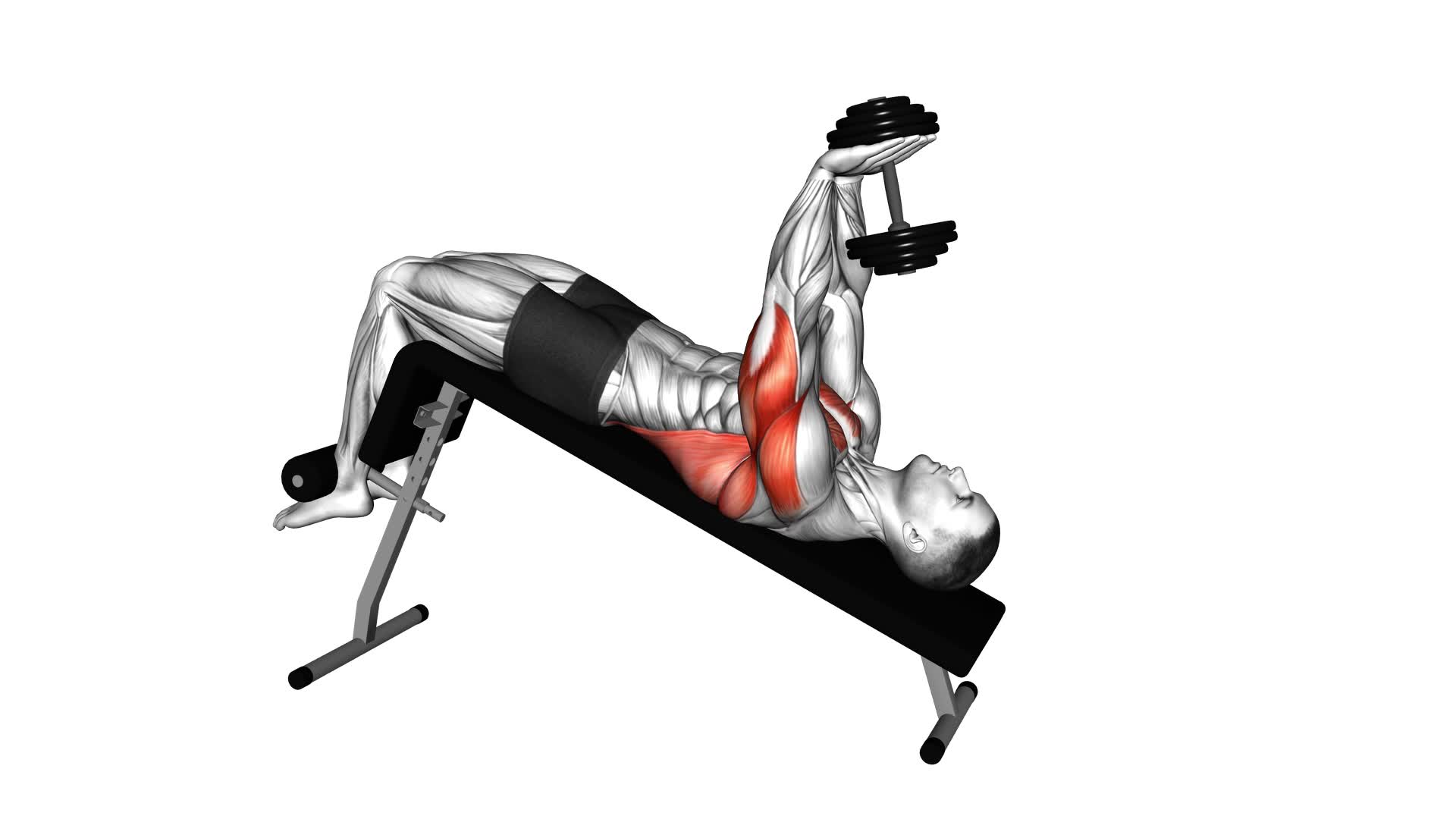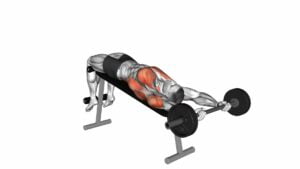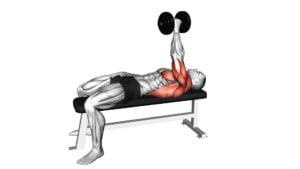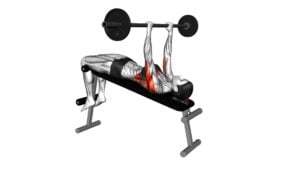Dumbbell Decline Pullover (male) – Video Exercise Guide & Tips

Looking to target your chest and back muscles? The dumbbell decline pullover is the perfect exercise for you. In this video exercise guide, you'll learn the proper form and technique, as well as variations to focus on specific muscles.
Watch This Exercise Video
Avoid common mistakes and maximize your results with our helpful tips. Get ready to take your workout to the next level with the dumbbell decline pullover.
Let's get started!
Key Takeaways
- The dumbbell decline pullover is a beneficial exercise for increasing chest and shoulder strength, engaging back muscles, and developing a balanced physique.
- Proper form and technique are essential for maximizing the benefits of this exercise, including choosing the appropriate dumbbell weight, positioning oneself correctly on a decline bench, and focusing on chest muscles.
- Incorporating variations and muscle activation techniques can help target specific muscles and improve overall fitness.
- It is important to avoid common mistakes such as incorrect form, using improper equipment, and neglecting proper breathing techniques, and to maximize results by choosing a challenging weight, engaging core muscles, controlling breathing, and gradually increasing weight over time.
Benefits of the Dumbbell Decline Pullover
Experience increased chest and shoulder strength by incorporating the dumbbell decline pullover into your workout routine. This exercise not only targets your chest and shoulders but also engages your back muscles, making it a great addition to your full body workout.
If you're looking for dumbbell decline pullover alternatives, this exercise is a fantastic option. It effectively isolates your chest and shoulders, allowing you to focus on these specific muscle groups and maximize your gains.
Incorporating pullovers into a full body workout offers numerous benefits. Not only does it strengthen your chest and shoulder muscles, but it also improves your overall upper body strength and stability. By targeting multiple muscle groups, the dumbbell decline pullover helps to enhance your posture and develop a balanced physique.
To get the most out of this exercise, it's important to maintain proper form and technique. Keep your core engaged and your back flat against the bench throughout the movement. Gradually lower the dumbbell behind your head until you feel a stretch in your chest and shoulders, and then lift it back up to the starting position. Remember to breathe and focus on the mind-muscle connection to optimize your results.
Now that you understand the benefits of the dumbbell decline pullover, let's move on to the next section and delve into the proper form and technique to ensure you perform this exercise correctly.
Proper Form and Technique
To perform the dumbbell decline pullover correctly, you should ensure that your form and technique are precise and focused. Here are four key tips to help you achieve optimal results:
- Start with the right equipment: Choose dumbbells that challenge your muscles but allow you to maintain proper form throughout the exercise. This will help prevent injury and maximize muscle building potential.
- Position yourself correctly: Lie on a decline bench with your feet secured, ensuring stability throughout the movement. Keep your core engaged and maintain a slight bend in your elbows to target the muscles effectively.
- Control the movement: Slowly lower the dumbbells behind your head, feeling a stretch in your chest and shoulders. As you bring the dumbbells back up, focus on using your chest muscles to lift the weight, rather than relying on momentum or excessive arm movement.
- Breathe and maintain stability: Exhale as you lift the dumbbells back up, and inhale as you lower them down. Keep your body steady and avoid arching your back or using excessive shoulder movement to maintain proper form.
Variations to Target Specific Muscles
Now that you have mastered the proper form and technique of the dumbbell decline pullover, it's time to explore variations that will help you target specific muscles.
One important aspect to consider is the difference between isolation and compound exercises. By incorporating both types into your routine, you can effectively work multiple muscle groups while also focusing on specific areas of weakness.
Muscle activation techniques such as pre-exhaustion or supersets can further enhance the effectiveness of your workouts. So, don't be afraid to mix things up and tailor your exercises to your individual goals and needs.
Isolation Vs Compound Exercises
When targeting specific muscles, it's important to understand the difference between isolation and compound exercises.
Isolation exercises focus on a single muscle group, while compound exercises work multiple muscle groups simultaneously.
Here are four key points to consider:
- Isolation exercises: These exercises target specific muscles, allowing you to isolate and strengthen them individually. Examples include bicep curls for the biceps or calf raises for the calves.
- Compound exercises: These exercises engage multiple muscle groups, making them more efficient for overall strength and muscle development. Examples include squats, deadlifts, and bench presses.
- Functional movements: Compound exercises mimic movements we use in everyday life, making them beneficial for improving coordination and stability.
- Time efficiency: Compound exercises allow you to work multiple muscle groups at once, saving you time in the gym and maximizing your workout session.
Incorporating a mix of isolation and compound exercises into your training routine can help you target specific muscles while also building overall strength and functionality. Remember, variety is key for achieving well-rounded fitness goals.
Muscle Activation Techniques
Start by incorporating variations of muscle activation techniques to target specific muscles during your workouts. Muscle activation techniques involve using specific exercises or movements to isolate and activate specific muscles, maximizing their engagement and growth.
By targeting specific muscles, you can address imbalances, weaknesses, or specific goals you may have. When performing muscle activation techniques, it's crucial to maintain proper form and technique to ensure effective and safe execution. This includes focusing on the mind-muscle connection, using the appropriate range of motion, and controlling the movement throughout.
By incorporating these techniques into your workouts, you can optimize your training and achieve better results.
Now, let's dive into targeting weak muscle groups to further enhance your overall strength and physique.
Targeting Weak Muscle Groups
To effectively target weak muscle groups and optimize your training, incorporate variations of muscle activation techniques that specifically isolate and activate those muscles. Strengthening exercises can help address muscle imbalances and improve overall muscle function. Here are four variations to target specific muscle groups:
- Single-leg exercises: Perform exercises such as lunges or single-leg squats to target and strengthen individual leg muscles. This helps address any imbalances between the left and right sides of your body.
- Isolation exercises: Incorporate exercises that isolate specific muscle groups, such as bicep curls or tricep extensions. By focusing on one muscle at a time, you can effectively strengthen weaker areas.
- Stability exercises: Use tools like stability balls or balance boards to challenge your core and improve stability. This helps target weak muscles in your core and improve overall balance.
- Resistance band exercises: Utilize resistance bands to add resistance to your workouts and target specific muscle groups. They can be easily incorporated into various exercises to target weak muscles and improve overall strength.
By incorporating these variations into your training routine, you can effectively target weak muscle groups and address any muscle imbalances, leading to a more balanced and functional physique.
Keep pushing yourself and never stop striving for improvement!
Common Mistakes to Avoid
To prevent injury and maximize results, make sure you aren't making these common mistakes while performing the dumbbell decline pullover exercise. Proper form is crucial to ensure muscle activation and avoid unnecessary strain.
One common mistake is using weights that are too heavy. It's important to choose a weight that allows you to maintain control throughout the exercise. Using weights that are too heavy can lead to poor form and increase the risk of injury.
Another mistake to avoid is arching your back excessively. This can put excessive stress on your lower back and take away the focus from the targeted muscles. Keep your back flat against the bench and engage your core to maintain stability.
Additionally, rushing through the exercise is another common mistake. It's important to perform each rep with control and full range of motion. Take your time and focus on feeling the stretch and contraction in your muscles.
Tips for Maximizing Results
To maximize your results from the dumbbell decline pullover exercise, focus on maintaining proper form and incorporating these tips:
- Maximize Intensity: To get the most out of this exercise, choose a weight that challenges you but still allows you to maintain proper form. Gradually increase the weight as you get stronger to continue pushing your limits and maximizing your results.
- Engage Your Core: Throughout the exercise, be sure to engage your core muscles by pulling your belly button towards your spine. This will help stabilize your body and prevent unnecessary strain on your lower back.
- Control Your Breathing: Proper breathing techniques can enhance the effectiveness of the dumbbell decline pullover. Inhale deeply before lowering the dumbbell, and exhale as you bring it back up. This controlled breathing will help you maintain focus and stability.
- Focus on the Stretch: As you lower the dumbbell behind your head, focus on feeling the stretch in your chest and lats. This will help improve your range of motion and target those muscles effectively.
By following these tips and incorporating them into your dumbbell decline pullover routine, you can maximize the intensity of your workouts and achieve better results.
Remember to listen to your body, maintain proper form, and stay consistent in your training.
Sample Workout Routine Incorporating the Dumbbell Decline Pullover
To incorporate the dumbbell decline pullover into your workout routine, consider performing it as part of a full-body strength training circuit.
This sample workout routine will help you maximize your results and target multiple muscle groups.
Start with a 5-minute warm-up to get your blood flowing and prepare your muscles for the workout.
Begin the circuit with compound exercises like squats or deadlifts to engage multiple muscle groups simultaneously.
Follow this with the dumbbell decline pullover, focusing on activating your chest, shoulders, and back muscles.
Remember to keep your core engaged and maintain proper form throughout the movement.
After completing a set of pullovers, move on to other exercises such as lunges, rows, or overhead presses to continue targeting different muscle groups.
Aim for 2-3 sets of 10-12 repetitions for each exercise, resting for 30-60 seconds between sets.
Finish the circuit with a cool-down and stretching routine to prevent muscle soreness.
By incorporating the dumbbell decline pullover into this sample workout routine, you can effectively activate and strengthen your upper body muscles while also engaging your core and lower body.
Stay consistent, challenge yourself, and enjoy the benefits of this full-body strength training circuit.
Frequently Asked Questions
How Often Should I Perform the Dumbbell Decline Pullover Exercise?
To get the most out of the dumbbell decline pullover exercise, it's important to find the right frequency for you.
The benefits of this exercise extend to different muscle groups, making it a versatile addition to your routine.
Experiment with performing it two to three times a week and see how your body responds.
Remember, consistency is key to seeing progress and reaching your fitness goals.
Keep pushing yourself and enjoy the results!
Can Women Also Benefit From Performing the Dumbbell Decline Pullover Exercise?
Yes, women can definitely benefit from performing the dumbbell decline pullover exercise. It offers several advantages, such as strengthening the chest, shoulders, and back muscles.
Additionally, this exercise can be modified to suit different fitness levels by adjusting the weight and angle of the decline bench.
So whether you're a beginner or advanced, the dumbbell decline pullover can be a great addition to your workout routine for improved upper body strength and toning.
Keep pushing yourself and see the amazing results!
Is It Necessary to Use a Decline Bench for This Exercise, or Can It Be Performed on a Flat Bench?
When it comes to the dumbbell decline pullover, you might be wondering if it's necessary to use a decline bench or if you can perform it on a flat bench.
Well, let me tell you, using a decline bench for this exercise can have its benefits. It allows for a greater range of motion and targets the lower chest muscles more effectively.
Are There Any Alternatives to the Dumbbell Decline Pullover Exercise That Target the Same Muscles?
Looking for alternatives to the dumbbell decline pullover that target the same muscles?
There are a few options you can try. One is the cable pullover, which works your lats and chest.
Another is the straight-arm pulldown, which targets your lats and shoulders.
And don't forget about the bent-over row, which hits your back and biceps.
These exercises can help you achieve similar muscle targeting goals without using the dumbbell decline pullover.
Keep pushing yourself and trying new exercises to keep your workouts fresh and effective.
Can the Dumbbell Decline Pullover Exercise Help Improve Core Strength as Well?
Yes, the dumbbell decline pullover exercise can indeed help improve core strength.
By engaging the muscles in your abdomen, back, and shoulders, this exercise targets your core, leading to improved stability and balance.
Additionally, the dumbbell decline pullover also aids in improving flexibility, making it a great exercise for athletes.
Conclusion
Incorporating the dumbbell decline pullover into your workout routine can have numerous benefits for your overall fitness. By targeting specific muscles in your upper body, this exercise helps build strength and improve posture.
Remember to maintain proper form and technique to maximize results and avoid common mistakes. With dedication and consistency, you can achieve great results and take your fitness to the next level.
So grab those dumbbells, get into position, and start pullover-ing towards your fitness goals!

Author
Years ago, the spark of my life’s passion ignited in my mind the moment I stepped into the local gym for the first time. The inaugural bead of perspiration, the initial endeavor, the very first surge of endorphins, and a sense of pride that washed over me post-workout marked the beginning of my deep-seated interest in strength sports, fitness, and sports nutrition. This very curiosity blossomed rapidly into a profound fascination, propelling me to earn a Master’s degree in Physical Education from the Academy of Physical Education in Krakow, followed by a Sports Manager diploma from the Jagiellonian University. My journey of growth led me to gain more specialized qualifications, such as being a certified personal trainer with a focus on sports dietetics, a lifeguard, and an instructor for wellness and corrective gymnastics. Theoretical knowledge paired seamlessly with practical experience, reinforcing my belief that the transformation of individuals under my guidance was also a reflection of my personal growth. This belief holds true even today. Each day, I strive to push the boundaries and explore new realms. These realms gently elevate me to greater heights. The unique combination of passion for my field and the continuous quest for growth fuels my drive to break new ground.







